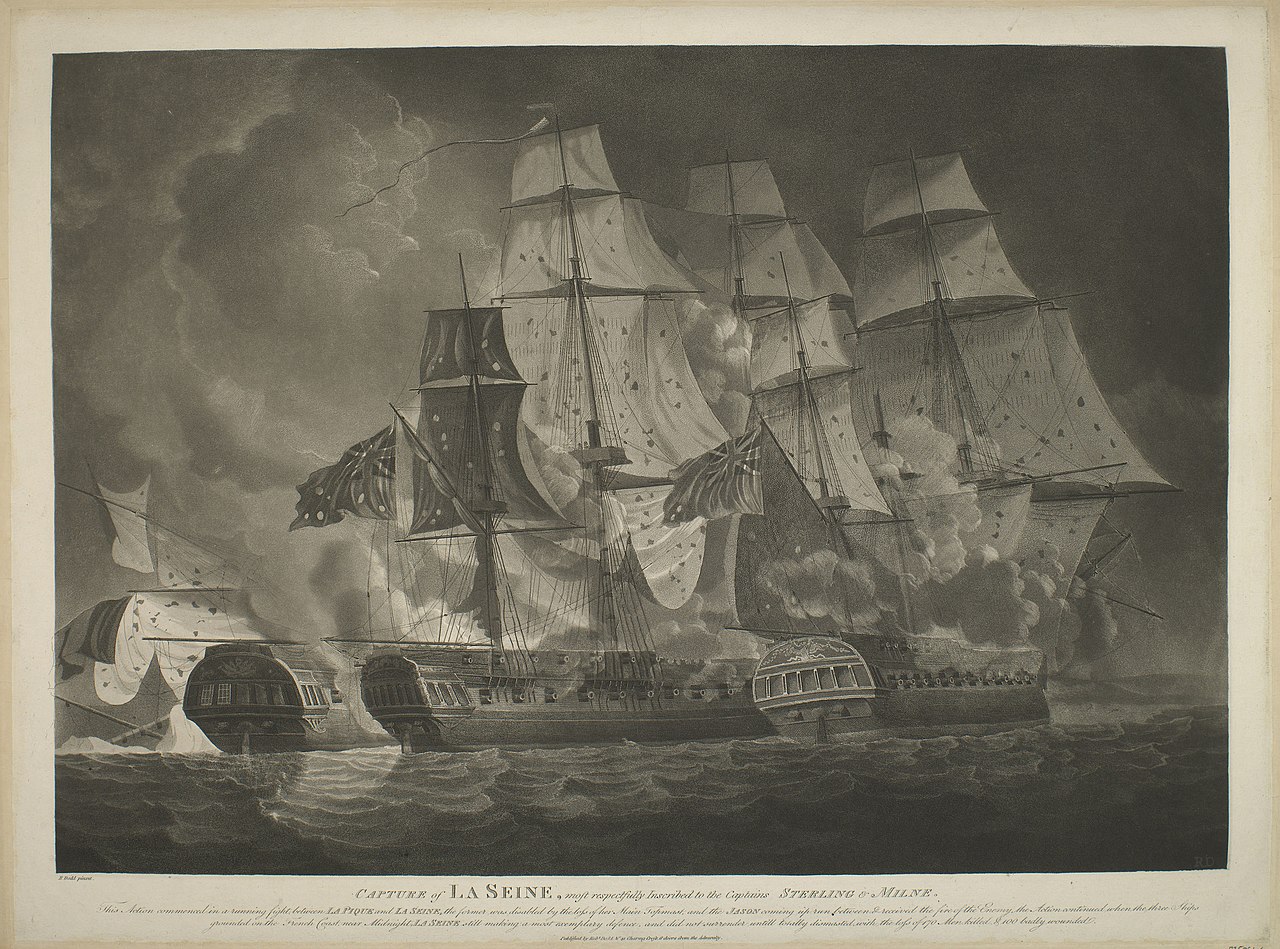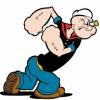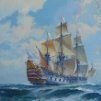-
Posts
2,245 -
Joined
-
Last visited
Reputation Activity
-
 Beef Wellington reacted to Wahka_est in HMS Cruiser by Wahka_est - Caldercraft - 1:64
Beef Wellington reacted to Wahka_est in HMS Cruiser by Wahka_est - Caldercraft - 1:64
Bulkwarks were glued nicely.
In this build i educate myself more with books and other material. Will try to make a huge jump in general quality and techniques also.
As it came to my mind that this hull isnt like Terroe i had to remove false keel in order to sand down keel at the areas where there arent any bulkhead. Otherwise planking would be 2mm over the false keel when finished.
Installed 3 planks. 1st blanks under gunport bulkhead went in without tapering. Will start tapering from 2nd plank.
Got new toy-Amati clamps. Good investment. Bad is that i cant install many planks at once.
So i prepared filler blocks for each bulkhead (tried to avoid that and rush into planking) that i will glue on at next build day. This means at each bulkhead i can glue it with pva and fix with superglue as i have enough surface to work on.
i allready see that planks are meeting the gunport bulkheads line at bow area in one place. I will cover that area with extra planks and sand it down at later stage of the build.
Question-should i apply 1st planking to the area where there isnt any bulkheads and its just keel? I should be logical to put only 2nd planking there that would meet with the false keel(rabbet line).
the area is sanded down with dremel for now.
-
 Beef Wellington got a reaction from Chuck Seiler in Where are my pumps?
Beef Wellington got a reaction from Chuck Seiler in Where are my pumps?
This is indeed a fascinating subject, and unfortunately I have nothing else to add other than musings. Intuitively it seems inherently a risky design to have the pump directly feed into water outside the keel as shown. This would make the entire pump case a watertight integrity hazard, failure anywhere in the pump casing below the waterline could result in severe, if not catastrophic, flooding. While this is clearly something used today in ship design, metal is much more of a robust engineered solution allowing multiple fail safe options in the event of accident or failure.
-
 Beef Wellington reacted to Dziadeczek in Where are my pumps?
Beef Wellington reacted to Dziadeczek in Where are my pumps?
On p. 142 I scanned above, it is stated that the cyllinders were made of elm, which is very hard and moisture resistant wood, additionally reinforced with iron rings, and this simple construction was very robust, requiring little, if any maintenance, only occasional replacement or greasing of the boxes (valves), so it is quite unlikely that these barrels were susceptible to cracking/ breaking, unless being directly hit by the enemy's fire during a battle. The text also says that the pump was capable to extract (suck) about 25 gallons of water per minute. I imagine, that if the barrel was cracked/broken, similar amount of water would rush into the bilges. Considering the size of the hull, this wouldn't be so much - after all, there were other pumps onboard to use...
Jean Boudriot says that in French vessels, the working part of this barrel was made from a bronze pipe, only upper and lower ends of the pump were made of elm. As we know, bronze is quite strong, unlikely to crack or corrode. It is used even nowadays for plumbing in certain countries, e.g. Germany...
I fully agree with you all, that the life onboard those vessels was very dangerous (not even considering loosing one's life during a battle, where opposing forces were desperatly trying to kill each other!). Even after all these years since then and numerous improvements, it is still one of the most dangerous occupations today!
BTW, I found out in B. Lavery's book an illustration, showing a combo-elm pump, which allowed drawing water from both sources, either an inner cistern or directly from the sea. Interesting...
Stay safe and healthy,
Thomas
-
 Beef Wellington reacted to Wahka_est in HMS Cruiser by Wahka_est - Caldercraft - 1:64
Beef Wellington reacted to Wahka_est in HMS Cruiser by Wahka_est - Caldercraft - 1:64
Got clearance from Admiral to do some heavy sanding so was able to move on - had to vacuum whole living after that.
Gunport bulkwark was the most complicated fit so far. Did it so that marked line on bulkwark where it should meet false deck. Fit isnt 100% perfect, some gaps, but 2nd layer will cover it.
Applied too much CA at bow so it ran on keel(heavy sanding awaits i guess). That was only way to get it to stick at deck.
As its my 2nd build i have learned a bit. Added some balsa filler blocks and intend to add some more before the planking. Some tore apart during sanding.
i know it dosent look nice at the moment but thats my style to make hull rock solid and it all will be covered.
Next is to finish with the keel and stren bulkwark.
-
 Beef Wellington got a reaction from Bluto 1790 in Where are my pumps?
Beef Wellington got a reaction from Bluto 1790 in Where are my pumps?
This is indeed a fascinating subject, and unfortunately I have nothing else to add other than musings. Intuitively it seems inherently a risky design to have the pump directly feed into water outside the keel as shown. This would make the entire pump case a watertight integrity hazard, failure anywhere in the pump casing below the waterline could result in severe, if not catastrophic, flooding. While this is clearly something used today in ship design, metal is much more of a robust engineered solution allowing multiple fail safe options in the event of accident or failure.
-
 Beef Wellington got a reaction from mtaylor in Where are my pumps?
Beef Wellington got a reaction from mtaylor in Where are my pumps?
This is indeed a fascinating subject, and unfortunately I have nothing else to add other than musings. Intuitively it seems inherently a risky design to have the pump directly feed into water outside the keel as shown. This would make the entire pump case a watertight integrity hazard, failure anywhere in the pump casing below the waterline could result in severe, if not catastrophic, flooding. While this is clearly something used today in ship design, metal is much more of a robust engineered solution allowing multiple fail safe options in the event of accident or failure.
-
 Beef Wellington reacted to harlequin in HMS Bellona by harlequin - FINISHED - Corel
Beef Wellington reacted to harlequin in HMS Bellona by harlequin - FINISHED - Corel
mast tops dead eyes in place using aforementioned method.
-
 Beef Wellington got a reaction from druxey in Where are my pumps?
Beef Wellington got a reaction from druxey in Where are my pumps?
This is indeed a fascinating subject, and unfortunately I have nothing else to add other than musings. Intuitively it seems inherently a risky design to have the pump directly feed into water outside the keel as shown. This would make the entire pump case a watertight integrity hazard, failure anywhere in the pump casing below the waterline could result in severe, if not catastrophic, flooding. While this is clearly something used today in ship design, metal is much more of a robust engineered solution allowing multiple fail safe options in the event of accident or failure.
-
 Beef Wellington reacted to Dziadeczek in Where are my pumps?
Beef Wellington reacted to Dziadeczek in Where are my pumps?
OK Bluto, here is the previous page nr. 142 from the above mentioned book. This should give you further explanations to your questions.
Not being any expert on pumps, I think that the water let inside the hull through those horizontal pipes from the openings in the bulwarks below the waterline, was directed into the watertight cistern, and from there it was sucked up, onto the decks by means of the elm tree pumps, to be used for cleaning the decks and/or for extinguishing fires, or such. An alternative was to draw water directly from the sea, without this cistern - look on the pic 5/14.
The stale water in the bilges was removed rather by the chain pumps - being more powerful than the elm tree pumps.
(also, in the book "The Arming and Fitting of English Ships of War 1600-1815" by Brian Lavery, there is an entire chapter (13 pages!) devoted just to pumps. If you read it, you'be an expert on the topic, for sure!) :-)
-
 Beef Wellington reacted to MEDDO in Queen Anne Barge by MEDDO - FINISHED - Syren - scale 1:24
Beef Wellington reacted to MEDDO in Queen Anne Barge by MEDDO - FINISHED - Syren - scale 1:24
Starting to get there I think. So far about 9ish coats of very thin paint. Seems like the last 2-3 really start to bring out the color.
Am waiting to paint the top of the caprail until the inner planking is in so I can make sure the gap is nice and clean and if needed the filler <gasp> can be blended in
(picture looks weird at the bottom moulding irl looks nice and straight)
-
 Beef Wellington reacted to ObviousNewbie in HMS Terror by ObviousNewbie - FINISHED - OcCre - Scale 1:75 - first wooden ship build
Beef Wellington reacted to ObviousNewbie in HMS Terror by ObviousNewbie - FINISHED - OcCre - Scale 1:75 - first wooden ship build
Small update: thnx Wahka_est! Tried out the combined CA/PVA approach, works like a charm:
Continuing tomorrow 🙂
-
 Beef Wellington reacted to ObviousNewbie in HMS Terror by ObviousNewbie - FINISHED - OcCre - Scale 1:75 - first wooden ship build
Beef Wellington reacted to ObviousNewbie in HMS Terror by ObviousNewbie - FINISHED - OcCre - Scale 1:75 - first wooden ship build
Hi all, it seems I do have more time on my hands: as the nails kept bothering me, instead of putting the Dremel on them I decided to remove them completely, and manually. That took some time, but here's the result:
A more smoother surface, and about 300 nails recuperated 🙂
Sanding has commenced, starting with the bow:
That was... interesting 🙂 As the plans call for straight pieces of plywood to be stacked and then sanded down, I used the Dremel with the hose to get the chunck off, before moving to the finer finish with the sanding blocks. I really need some Dremel 101 because I managed to make 2 small dents in the bow wood on the starboard side, which I can fill with wood filler of course (got my hands on that before the lockdown went into effect). Another lesson learned.
After that manual sanding, and I found the P180 is doing a much better job than the P60 I was using before. Conitued using that on the hull:
Still a working progress, but am I correct in assuming there's 3 phases to hull sanding:
1: Basic levelling, exposing areas that cannot be sanded down and need to be filled with wood filler
2: Use the wood filler
3: Sand down the wood filler and finalise.
Also, I found the best way to discover unevenness is to use your fingers and go by touch. That led to some strange looks from the Admiral and the Rear-Admiral (17-year old daughter) 🙂 Am I missing a technique I haven't read about?
-
 Beef Wellington reacted to ObviousNewbie in HMS Terror by ObviousNewbie - FINISHED - OcCre - Scale 1:75 - first wooden ship build
Beef Wellington reacted to ObviousNewbie in HMS Terror by ObviousNewbie - FINISHED - OcCre - Scale 1:75 - first wooden ship build
Busy week last week, managed to do some work nonetheless.. And my first blunder 🙂
After testing the varnish, I planned to move ahead: glueing the deck on the bulkheads, bending, painting and attaching the bulwarks. First experiences with the CA glue were... interesting. Mind you, I got the thin CA, which was not really suited for attaching the deck. Friend of mine gave me some advice to try this out:
CA glue, but a gel, easy to apply even with a spatula if necessary. In short, good stuff. After some tests I attached the deck without any issue. Next up, bending the bulwarks. Did a lot of reading and asked for advice (thnx Wahka_est!) and went for it: put the 2 bulwarks in piping hot water and let soak for an hour. Then bending them around a tin can:
Worked like a charm... But after allowing them to dry I realised I apparently choose to neglect my marks on the wood and bent both bulwarks in the same direction. After a brief moment of panic and a dash to find the Occre support contact, decided to simply put the wood back in the water, and try and bend it the other way. To my surprise, not a minute after re-immersing the bulwark in the water, the curve straightened itself out. Let it soak, bent it carefully the other way, let dry. What a material, you try doing that with plastic 🙂
After varnishing the bent bulwarks, planned the assembly to the hull. Stern fitted perfectly, some CA was going to be needed for the front, and here we are:
Far from perfect, but a good first try, I think. I'm going to let the hull dry overnight and then fairing commences 🙂
-
 Beef Wellington reacted to Gremreeper1967 in Need advice bending .5mm strips
Beef Wellington reacted to Gremreeper1967 in Need advice bending .5mm strips
It's not pretty but I won't make the same mistakes again.
-
 Beef Wellington got a reaction from CaptainSteve in Queen Anne Style Royal Barge c1700 by Beef Wellington - Syren Ship Model Company - 1:24
Beef Wellington got a reaction from CaptainSteve in Queen Anne Style Royal Barge c1700 by Beef Wellington - Syren Ship Model Company - 1:24
Glad to have you follow along Jean-Paul, I very much enjoyed reading through your QAB log, a model to aspire to.
Frame Installation:
Additional work done on the keel was some final shaping of the stern post, finishing of the keel taper, installation of the transom, and a coat of wipe on poly for protection. One thing I have noticed with cherry is the grain can cause optical illusions. In a couple of places I know the surface is as smooth as I can make it, but the grain makes it appear quite course still.
I had been working on making up the frames for some time, for many this simply requires to a frame foot to be glued to its corresponding futtock after cleaning off some areas of laser char. Pretty simple as each has its own guideline which is well explained in the instructions. The grooves on the assembly board needed to be filed out a little to allow the frames to be inserted, primarily due to the thickness of the wood and the slight angle introduced by the laser cutter.
I think this is good opportunity to share an observation about the kit. It is definitely a well thought out design with very clear instructions, however, that does not mean that some experience is not required as I was soon to find out....I'm sharing my experience below because every other build log of this kit seems to go together without a hitch, so a little humbling that I found this so problematic.
First Attempt:
First off, the assembled frames were inserted and the keel glued according to the instructions making sure that frames aligned well beforehand and that the bottom of the frame floor were at the right height to sit in the keel, and best effort to keep this in a straight line as well as by eyeball trying to keep what will be the top of the frames smoothly aligned. Everything seemed to work fine, and once the glue had had sufficient time to set, I started to fair the frames. This is when a first inkling of problems started, I noticed that some of the frames were moving in their slots, and upon further investigation some the frames were not really secured solidly to the keel. Although the planking will definitely add to the strength, I wasn't convinced the frames would be rigid enough to allow planks to be installed. Given the construction method, its not possible to remove and re-glue a single frame, so the isopropyl alcohol was brought out to remove all the frames....
Second Attempt:
Upon analysis two things became clear. I hadn't used enough glue in the joints, and that my judgement of what 'play' was needed for the frames in the build board was wrong (the instructions say that these shouldn't be too tight or too loose), but it was really only trying to go through the process of fairing that indicated what this should be. Some tape was added as suggested in the instructions to more rigidly seat these, and the process to align and glue repeated (using more glue this time around). Unfortunately, in the final stages of seating everything, I somehow placed too much pressure on frame G and the result was that the frame foot broke in two places, and the small tabs on one side of the futtock popped prematurely (these are weak by design to allow easier removal at a later stage). The isopropyl alcohol was brought out once more to remove all the frames........I don't have any photos of this, honestly I was too despondent to record it...
Third (and so far final attempt):
After examining the break, the cherry had broken with the grain and looked like it could be repaired. These are delicate pieces, but I don't think will be subject to much stress once the planks are on. The breaks were located on each side of the foot where there is a small dark element of grain, and can just be seen in photos below. The small tabs on the futtock were also given a tiny spot of glue, and to hopefully provide a little more strength a splint was glued to the central section to absorb some of the shearing forces that will be unavoidable while fairing the frames (this is NOT glued to the actual futtock itself).
So far, things seem to be back on track, and work has resumed on fairing the frames which is where things sit currently.
-
 Beef Wellington got a reaction from popeye the sailor in Canadian Pacific Wood Passenger Cars by Realworkingsailor - 1:87 - scratch-built & kit-bashed
Beef Wellington got a reaction from popeye the sailor in Canadian Pacific Wood Passenger Cars by Realworkingsailor - 1:87 - scratch-built & kit-bashed
Interesting subject Andy, definitely want to see how this plays out.
-
 Beef Wellington reacted to captain_hook in HMS Speedy by Vane - Vanguard Models - Scale 1:64 - Master Shipwright (limited edition)
Beef Wellington reacted to captain_hook in HMS Speedy by Vane - Vanguard Models - Scale 1:64 - Master Shipwright (limited edition)
AFAIK it depends on the curvature of the deck. If the deck is rather flat (which is the case for bigger ships) most gunports are rather square or rectangled. But take a look at the NMM Plan below (don‘t know if it is speedy or something lookalike). If you follow the deck to the left (stern) or the right (bow) the gunports become more like parallelograms. This is because the sides are defined by the frames of the ship which are usually orthogonal to the waterline or keel while the upper and lower edges of the gunports and sweepports following the deck (and its curve, indicated by the red line on the plan).
-
 Beef Wellington got a reaction from popeye the sailor in HMCSS Victoria 1855 by BANYAN - 1:72
Beef Wellington got a reaction from popeye the sailor in HMCSS Victoria 1855 by BANYAN - 1:72
Quite a bit to catch up on Pat, but as others have said your metalwork and soldering are just fantastic. Looking forward to a few more overall beauty shots hopefully soon 🙂
-
 Beef Wellington got a reaction from popeye the sailor in HMCSS Victoria 1855 by BANYAN - 1:72
Beef Wellington got a reaction from popeye the sailor in HMCSS Victoria 1855 by BANYAN - 1:72
Fantastic metalwork Pat, pleasure to catch up on all the great progress, the small details are the 'fun' things but make the model IMHO. Would love to have your abilities here!
-
 Beef Wellington reacted to Voyageur in Dinghy by Voyageur - FINISHED - Midwest Products - small - first ship model build ever
Beef Wellington reacted to Voyageur in Dinghy by Voyageur - FINISHED - Midwest Products - small - first ship model build ever
Well, here is my finished dinghy. Not perfect but I think she’s seaworthy. Thanks for your likes and comments!
on to my next project...
-
 Beef Wellington reacted to realworkingsailor in Canadian Pacific Wood Passenger Cars by Realworkingsailor - 1:87 - scratch-built & kit-bashed
Beef Wellington reacted to realworkingsailor in Canadian Pacific Wood Passenger Cars by Realworkingsailor - 1:87 - scratch-built & kit-bashed
Hello all, thanks for the comments and likes.
Time for another small update.
As mentioned in a previous post, I have largely been unable to locate a proper drawing for this particular car, but I do have a drawing of the smaller version in a book:
This was just a quick photograph of the folio drawing. The book, "From Abbey to Zorra via Bagdad" by Dale Wilson, is a based on a copy of the 1955 CPR passenger timetable, and includes many images of some of the passenger rolling stock used by the CPR, as well as copies of the 1949 and 1960 passenger equipment registers. Although the above drawing is of the smaller car, the interior layout is generally the same as the car I am attempting to build.
Moving along with the build, I've finished the trim on the corridor side of the car, there is only a few remaining pieces of 1/4 round that will frame the doors (that will have to wait until the car sides and ends are assembled), as well as the mullions for the transom windows. I've also begun work on the smoking room side of the car, cutting out the windows on the sub-side layer.
This tedious task has now been completed (thankfully)
The two layers have now been glued up. After the glue has had a chance to set, the next step will involve cutting out the transoms on the outer layer, as was done on the corridor side. Although tedious and repetitive, things are still moving forward at a fairly steady pace, assembly is starting to look like a looming possibility.
Andy
-
 Beef Wellington reacted to Helli in HMS Victory by Helli - Caldercraft
Beef Wellington reacted to Helli in HMS Victory by Helli - Caldercraft
Hi,
Now i can start rigging the cannons. Seems to be almost endless but is fun
After I had finished rigging I started the details on the upper gun deck
The first thing i did was assemble the bilge pump
Then i assembled the stairs and the railing
Finally I sanded the skid beam support pillars square and glued it on deck
After everything was done, I started fitting the quarterdeck. The assembly of the sliding clamps was a bit tricky
The planking of the quarterdeck can begin
I have cut off the bulkhead so that I can assemble the inner gunport patterns and planked it
Then I painted them
Forecastle breast beam
Bellhouse
Now all the details on the inner gunport
Assemble the copper profiles and the channels
In the channels I drilled a 1 mm hole and put in a brass pin with cut off the head.
So that i can mount the channels on the hull Helli
-
 Beef Wellington got a reaction from mtaylor in Where are my pumps?
Beef Wellington got a reaction from mtaylor in Where are my pumps?
According to TFFM the elm tree pumps also terminate in the bilge, very similar to the low point of the chain pumps. Your identification of the placement for the elmtree pumps is consistent in the photo above.
-
 Beef Wellington got a reaction from Bill Morrison in HMS Victory by Helli - Caldercraft
Beef Wellington got a reaction from Bill Morrison in HMS Victory by Helli - Caldercraft
You have a very fine model coming together there Helli.
-
 Beef Wellington reacted to cog in Messerschmitt bf 109G cockpit by cog - Eduard (brassin) - 1/48 - FINISHED
Beef Wellington reacted to cog in Messerschmitt bf 109G cockpit by cog - Eduard (brassin) - 1/48 - FINISHED
Since I have little time, I left my SMS Seydlitz in her mothballs and picked up this little build.
The only thing I can say: "it is small!!!" and it is almost finished before you start it
Resin and PE ready for painting
Base coat "Black base" with chrome - both AK extreme metal colours - enamels
Base colour is RLM 66 some details filled in with colours, and metal PE which has been prepainted - Vallejo acrylics - added a bit of wear and tear
Getting the PE, resin, and plastic fitted took the better part of an eveing, painting took in all about 1.5 - 2 hours. Quite a fun model to build despite it's size, lot's of detail on the resin parts too
Cheers









